1993 PONTIAC BONNEVILLE mirror
[x] Cancel search: mirrorPage 46 of 322
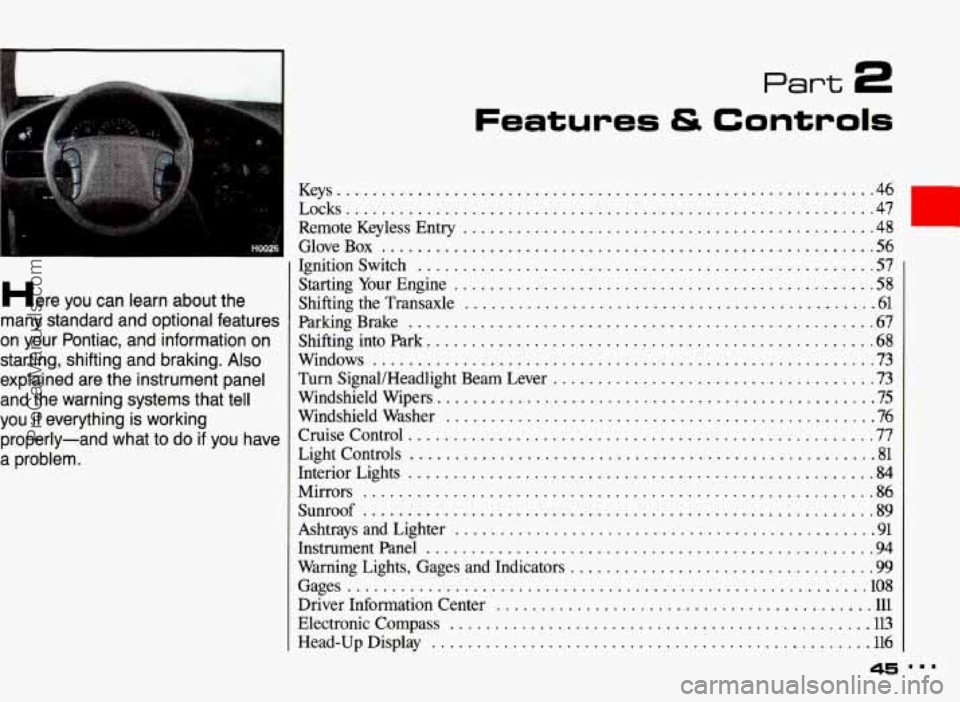
... Part 2
Features & Controls
Here you can learn about the
many standard and optional features
on your Pontiac. and information on
starting. shifting and braking
. Also
explained are the instrument panel
and the warning systems that tell
you
if everything is working
properly-and what to do
if you have
a problem
.
Keys ............................................................ 46
Locks
........................................................... 47
Remote Keyless Entry
.............................................. 48
GloveBox
....................................................... 56
Ignitionswitch ................................................... 57
StartingYourEngine
............................................... 58
Shifting the Transaxle
............................................. -61
ParkingBrake .................................................... 67
Shifting into Park
........ ...................................... 68
Windows ........................................................ 73
Turn SignaUHeadlight Beam Lever
.................................... 73
Windshield Wipers
................................................. 75
Windshield Washer
................................................ 76
CruiseControl
.................................................... 77
Lightcontrols
.................................................... 81
Interior Lights .................................................... 84
Mirrors
......................................................... 86
Sunroof ......................................................... 89
Ashtrays and Lighter
.............................................. -91
Instrument Panel ................................................... 94
Warning Lights, Gages and Indicators
.................................. 99
Gages
.......................................................... 108
Driver Information Center .......................................... 111
Electronic Compass ............................................... 113
Head-Up Display ............................................... 116
ProCarManuals.com
Page 87 of 322
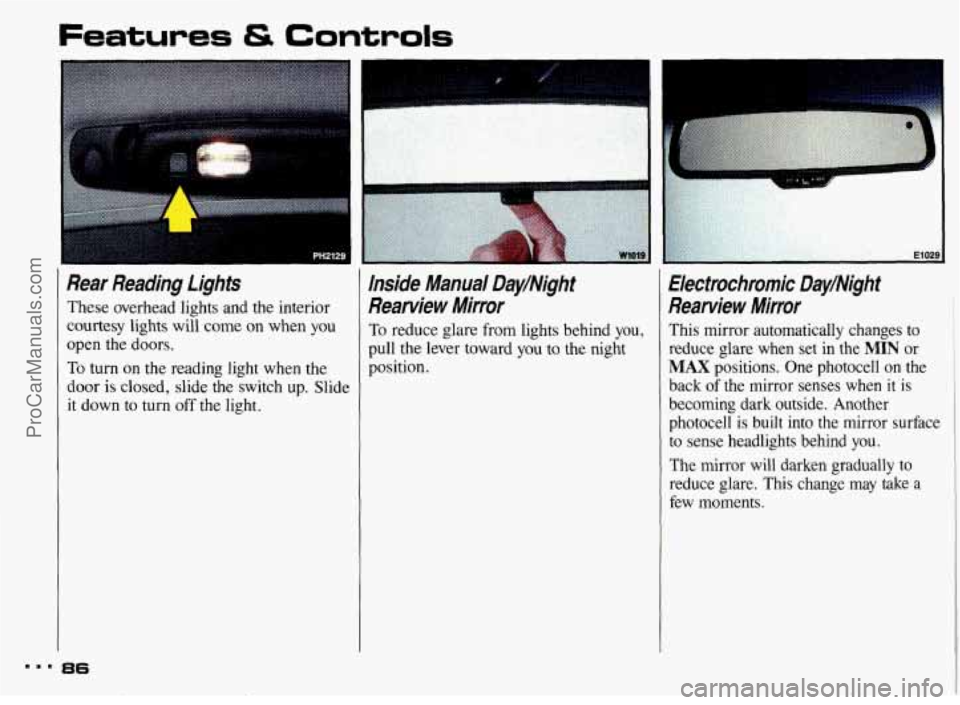
Features & Controls
Rear Reading Lights
These overhead lights and the interior
courtesy lights will come on when
you
open the doors.
To turn on the reading light when the
door
is closed, slide the switch up. Slide
it down to turn off the light.
Inside Manual Day/Night
Rearview Mirror
To reduce glare from lights behind you,
pull the lever toward you to the night
position.
Electrochromic DayINight
Rearview Mirror
This mirror automatically changes to
reduce glare when set in the
MIN or
MAX positions. One photocell on the
back
of the mirror senses when it is
becoming dark outside. Another
photocell
is built into the mirror surface
to sense headlights behind you.
The mirror will darken gradually to
reduce glare. This change may
take a
few moments.
ProCarManuals.com
Page 88 of 322

El 030 I
Setting the Sensitivity:
MIN: The mirror will gradually reduce
glare when headlights behind you are
very close. This is a good position for
city driving, where there may be light
from many sources.
MAX: The mirror will begin to
gradually reduce glare when headlights
are far behind you. This is
a good
setting for rural driving.
The mirror goes to a clear position whenever you shift to
R (Reverse).
OFF: Shuts off the Day/Night function.
The mirror will stay
in the Day setting.
To keep the photocells operating well,
occasionally clean them with
a cotton
swab and glass cleaner.
Convex Outside Mirror
Your right side mirror is convex. A
convex mirror’s surface is curved so you
can see more from the driver’s seat.
r
- If you aren’t used to a convex I
- mirror, you can hit another
vehicle.
A convex mirror can make
things (like other vehicles)
look
farther away than they really are. If
you cut too sharply into the right
lane,
you could hit a vehicle on
your right. Check your inside
mirror or glance over your
shoulder before changing lanes.
I
Manual Remote Control Mirror
The outside rearview mirror should be
adjusted
so you can just see the side of
your vehicle when you are sitting in a
comfortable driving position.
Adjust the driver side outside mirror
with the control lever
on the driver’s
door.
To adjust your passenger side mirror, sit
in the driver’s seat and have a passenger
adjust the mirror for you.
I D ProCarManuals.com
Page 89 of 322
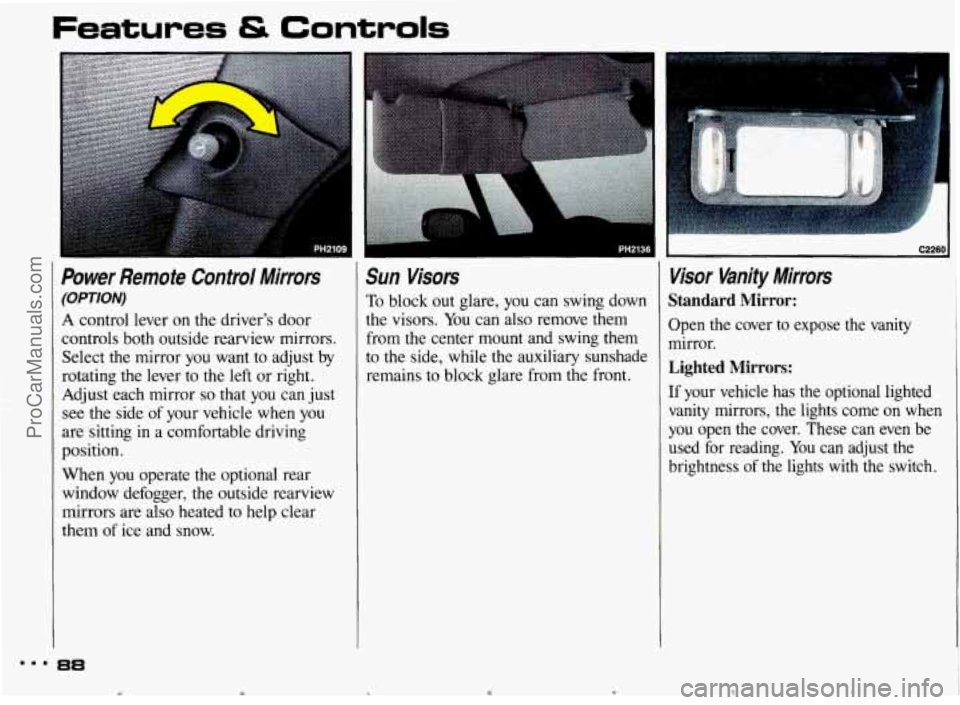
Features & Controls
Power Remote Control Mirrors
(OPTION)
A control lever on the driver's door
controls both outside rearview mirrors.
Select the mirror you want to adjust
by
rotating the lever to the left or right.
Adjust each mirror
so that you can just
see the side of your vehicle
when you
are sitting
in a comfortable driving
position.
When you operate the optional rear
window defogger, the outside rearview
mirrors are also heated to help clear
them of ice and snow.
Sun Visors
To block out glare, you can swing down
the visors. You can also remove them
from the center mount and swing them
to the side, while the auxiliary sunshade
remains to block glare from the front.
laaria1 C2260
Visor Vanity Mirrors
Standard Mirror:
Open the cover to expose the vanity
mirror.
Lighted Mirrors:
If your vehicle has the optional lighted
vanity mirrors, the lights come
on when
you open the cover. These can even be
used for reading.
You can adjust the
brightness of the lights
with the switch.
m.. 88
e t ProCarManuals.com
Page 125 of 322
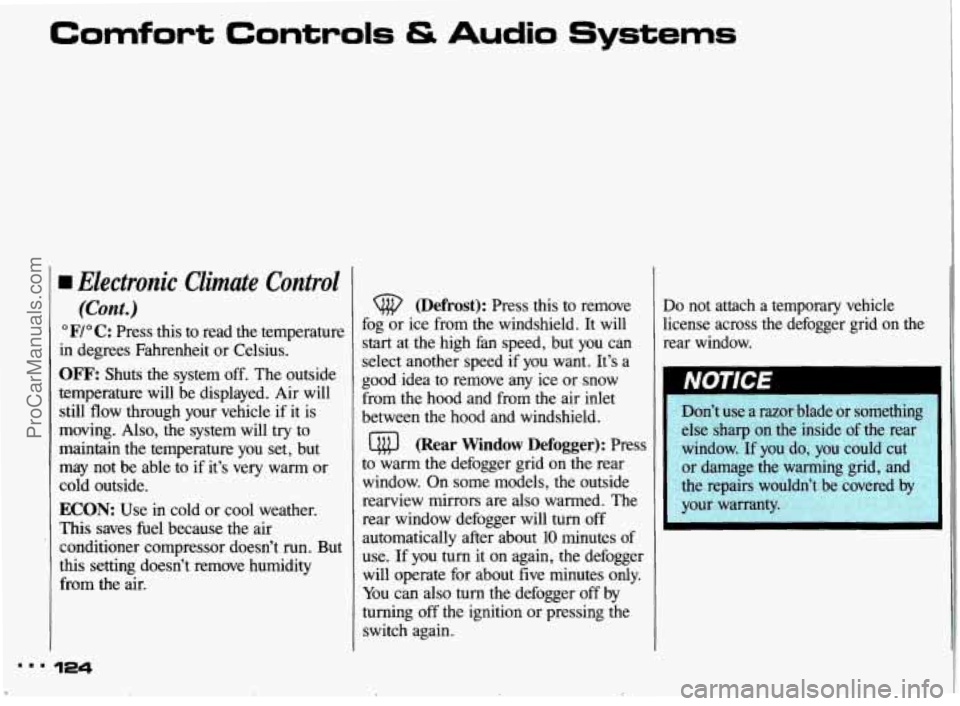
Comfort Controls & Audio Systems
Electronic Climate Control
(Cont.)
OF/” C: Press this to read the temperature
in degrees Fahrenheit or Celsius.
OFF: Shuts the system off. The outside
temperature will be displayed. Air will
still
flow through your vehicle if it is
moving. Also, the system will try to
maintain the temperature you set, but
may not be able to if it’s very warm or
cold outside.
ECON: Use in cold or cool weather.
This saves
fuel because the air
conditioner compressor doesn’t
run. But
this setting doesn’t remove humidity
from the air.
(Defrost): Press this to remove
fog or ice from the windshield. It will
start at the high fan speed, but you can
select another speed
if you want. It’s a
good idea to remove any ice or snow
from the hood and from
the air inlet
between the hood and windshield.
@ (Rear Window Defogger): Press
to warm the defogger grid
on the rear
window.
On some models, the outside
rearview mirrors are also warmed. The
rear window defogger will turn off
automatically after about
10 minutes of
use.
If you turn it on again, the defogger
will operate for about five minutes
only.
You can also turn the defogger off by
turning off the ignition or pressing the
switch again.
Do not attach a temporary vehicle
license across the defogger grid
on the
rear window.
Don’t
use a razor blade or something
else sharp on the inside
of the rear
window.
If you do, you could cut
or damage the warming grid, and
the repairs wouldn’t be covered by
your warranty.
1.1 124
ProCarManuals.com
Page 164 of 322
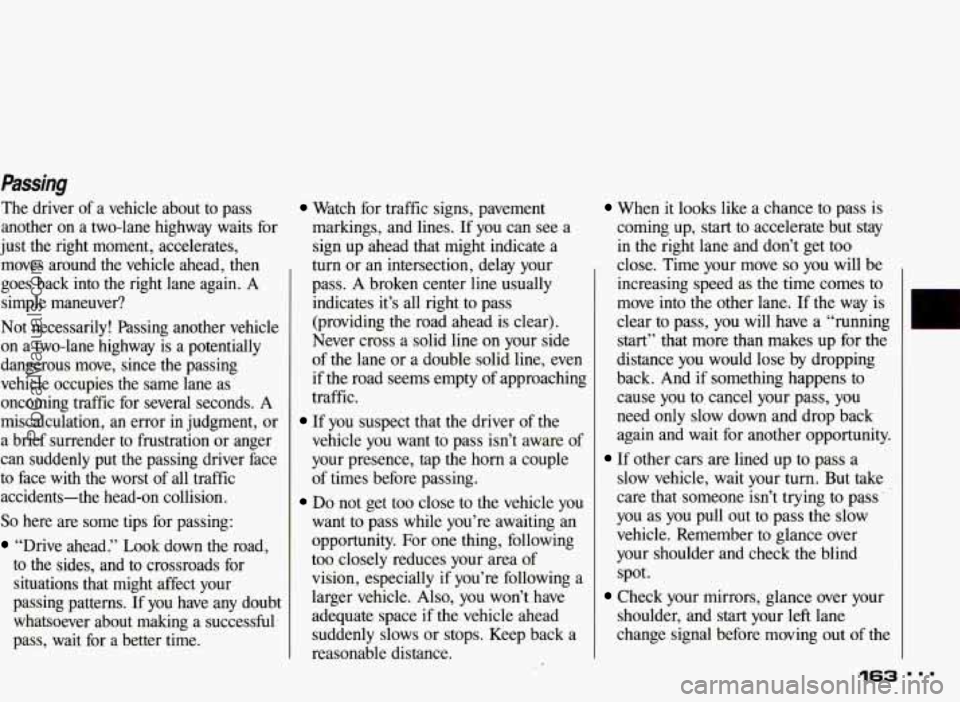
Passing
The driver of a vehicle about to pass
another on a two-lane highway waits for
just the right moment, accelerates,
moves around
the vehicle ahead, then
goes back into the right lane again.
A
simple maneuver?
Not necessarily! Passing another vehicle
on a two-lane highway is a potentially
dangerous move, since the passing
vehicle occupies the same lane as
oncoming traffic for several seconds.
A
miscalculation, an error in judgment, or
a brief surrender to frustration or anger
can suddenly put the passing driver face
to face with the worst of all traffic
accidents-the head-on collision.
So here are some tips for passing:
“Drive ahead.” Look down the road,
to the sides, and to crossroads for
situations that might affect your
passing patterns. If you have any doubt
whatsoever about making a successful.
pass, wait for a better time.
Watch for traffic signs, pavement
markings, and lines.
If you can see a
sign up ahead that might indicate a
turn or an intersection, delay your
pass. A broken center line usually
indicates it’s all right to pass
(providing the road ahead is clear).
Never cross a solid line
on your side
of the lane or a double solid line, even
if the road seems empty of approaching
traffic.
vehicle you want
to pass isn’t aware of
your presence, tap the horn a couple
of times before passing.
Do not get too close to the vehicle you
want to pass while you’re awaiting an
opportunity. For one thing, following
too closely reduces your area of
vision, especially if you’re following
a
larger vehicle. Also, you won’t have
adequate space
if the vehicle ahead
suddenly slows or stops. Keep back a
reasonable distance.
If you suspect that the driver of the
When it looks like a chance to pass is
coming up, start to accelerate but stay
in the right lane and don’t get too
close. Time your move
so you will be
increasing speed as the time comes to
move into the other lane. If the way is
clear to pass, you will have a “running
start’’ that more than makes up for the
distance you would lose by dropping
back. And if something happens to
cause you to cancel your pass,
you
need only slow down and drop back
again and wait for another opportunity.
slow vehicle, wait your turn. But take
care that someone isn’t trying to pqss
you as
you pull out to pass the slow
vehicle. Remember to glance over
your shoulder and check the blind
spot.
Check your mirrors, glance over your
shoulder, and start your left lane
change signal before moving out
of the
If other cars are lined up to pass a
L
163
ProCarManuals.com
Page 165 of 322
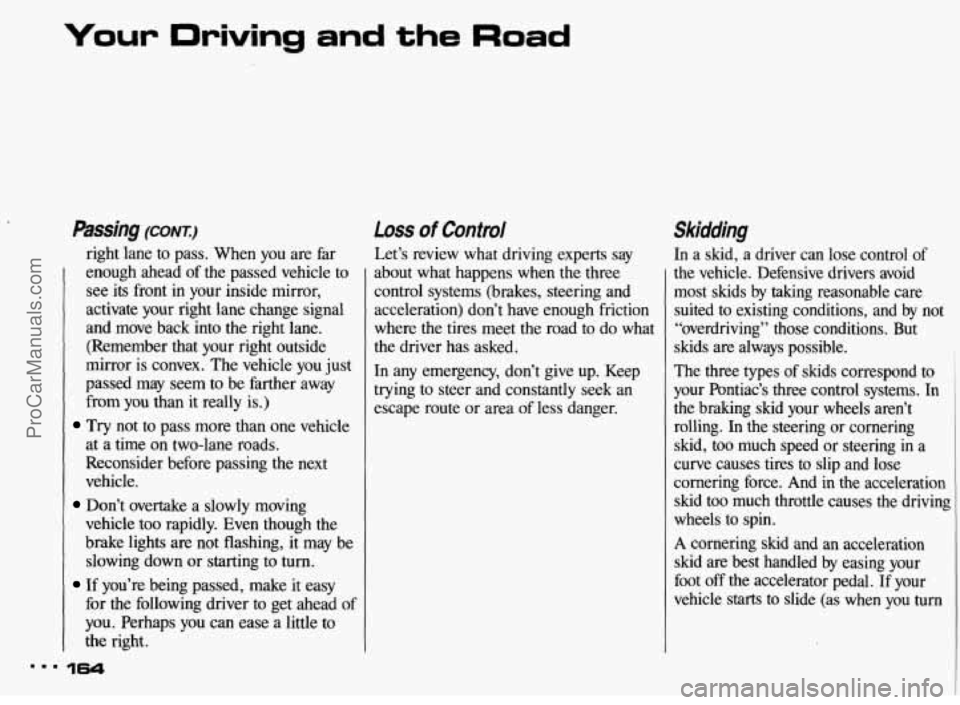
Your Driving and the Road
Passing (CONX:)
right lane to pass. When you are far
enough ahead of the passed vehicle to
see its front in your inside mirror,
activate your right lane change signal
and move back into the right lane.
(Remember that your right outside
mirror is convex. The vehicle you just
passed may seem to be farther away
from you than it really is.)
Try not to pass more than one vehicle
at a time on two-lane roads.
Reconsider before passing the next
vehicle.
vehicle too rapidly. Even though the
brake lights are not flashing,
it may be
slowing down or starting to
turn.
If you’re being passed, make it easy
for the following driver to get ahead
of
you. Perhaps you can ease a little to
the right.
Don’t overtake a slowly moving
Loss of Control
Let’s review what driving experts say
about what happens when the three
control systems (brakes, steering and
acceleration) don’t have enough friction
where the tires meet the road to do what
the driver has asked.
In any emergency, don’t give up. Keep
trying to steer and constantly seek
an
escape route or area of less danger.
Skidding
In a skid, a driver can lose control of
the vehicle. Defensive drivers avoid
most skids by taking reasonable care
suited to existing conditions, and by not
“overdriving” those conditions. But
skids are always possible.
The three types of skids correspond to
your Pontiac’s three control systems. In
the braking skid your wheels aren’t rolling. In the steering or cornering
skid, too much speed or steering in a
curve causes tires to slip and lose
cornering force. And in the acceleration
skid too much throttle causes the driving
wheels
to spin.
A cornering skid and an acceleration
skid are best handled by easing your
foot
off the accelerator pedal. If your
vehicle starts to slide (as when
you turn
ProCarManuals.com
Page 166 of 322
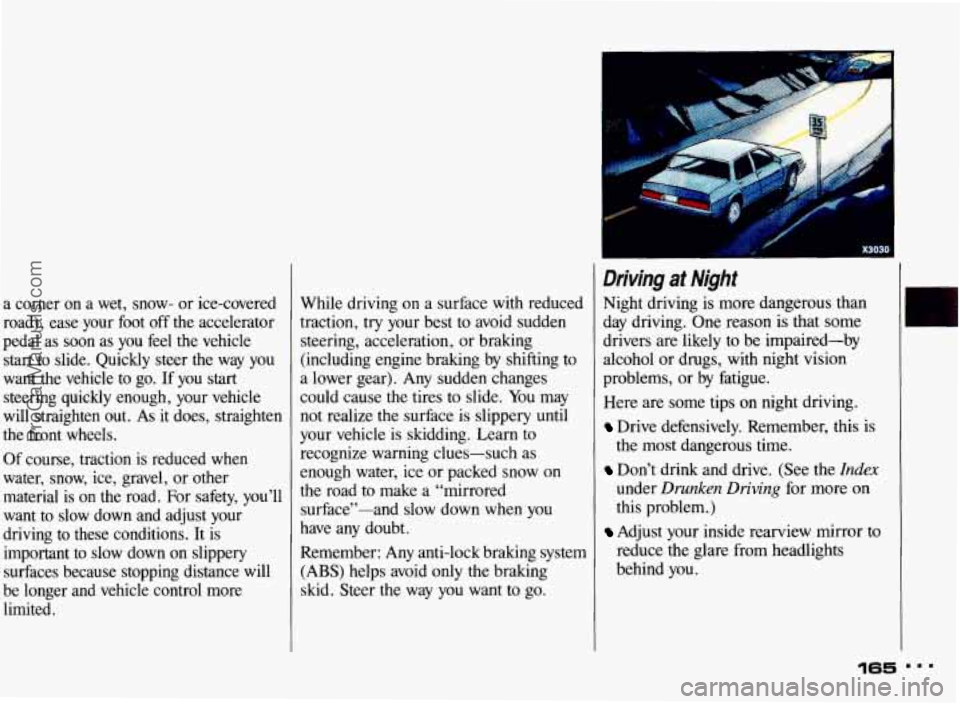
a corner on a wet, snow- or ice-covered
road), ease your foot off the accelerator
pedal as soon as you feel the vehicle
start to slide. Quickly steer the way you
want the vehicle to go. If you start
steering quickly enough, your vehicle
will straighten out. As it does, straighten
the front wheels.
Of course, traction is reduced when
water, snow, ice, gravel, or other
material is
on the road. For safety, you’ll
want to slow down and adjust your
driving to these conditions. It is
important to slow down on slippery
surfaces because stopping distance will
be longer and vehicle control more
limited. While
driving on a surface with reduced
traction, try your best
to avoid sudden
steering, acceleration, or braking
(including engine braking by shifting
to
a lower gear). Any sudden changes
could cause the tires to slide. You may
not realize the surface
is slippery until
your vehicle is skidding. Learn to
recognize warning clues-such as
enough water, ice
or packed snow on
the road to make a “mirrored
surface”-and slow down when
you
have any doubt.
Remember: Any anti-lock braking system
(ABS) helps avoid only the braking
slud. Steer the way you want to go.
Driving at Night
Night driving is more dangerous than
day driving. One reason is that some
drivers are likely to be impaired-by
alcohol or drugs, with night vision
problems, or by fatigue.
Here are some tips on night driving.
Drive defensively. Remember, this is
the most dangerous
time.
Don’t drink and drive. (See the Index
under Drunken Driving for more on
this problem.)
Adjust your inside rearview mirror to
reduce the glare from headlights
behind you.
165
ProCarManuals.com